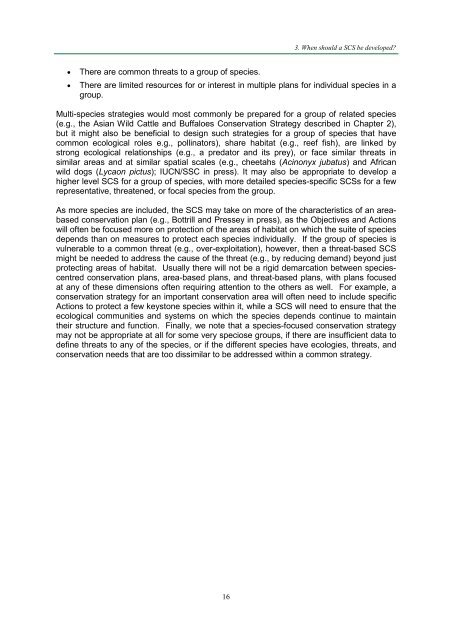Strategic Planning for Species Conservation: A Handbook - IUCN
Strategic Planning for Species Conservation: A Handbook - IUCN
Strategic Planning for Species Conservation: A Handbook - IUCN
You also want an ePaper? Increase the reach of your titles
YUMPU automatically turns print PDFs into web optimized ePapers that Google loves.
• There are common threats to a group of species.<br />
16<br />
3. When should a SCS be developed?<br />
• There are limited resources <strong>for</strong> or interest in multiple plans <strong>for</strong> individual species in a<br />
group.<br />
Multi-species strategies would most commonly be prepared <strong>for</strong> a group of related species<br />
(e.g., the Asian Wild Cattle and Buffaloes <strong>Conservation</strong> Strategy described in Chapter 2),<br />
but it might also be beneficial to design such strategies <strong>for</strong> a group of species that have<br />
common ecological roles e.g., pollinators), share habitat (e.g., reef fish), are linked by<br />
strong ecological relationships (e.g., a predator and its prey), or face similar threats in<br />
similar areas and at similar spatial scales (e.g., cheetahs (Acinonyx jubatus) and African<br />
wild dogs (Lycaon pictus); <strong>IUCN</strong>/SSC in press). It may also be appropriate to develop a<br />
higher level SCS <strong>for</strong> a group of species, with more detailed species-specific SCSs <strong>for</strong> a few<br />
representative, threatened, or focal species from the group.<br />
As more species are included, the SCS may take on more of the characteristics of an areabased<br />
conservation plan (e.g., Bottrill and Pressey in press), as the Objectives and Actions<br />
will often be focused more on protection of the areas of habitat on which the suite of species<br />
depends than on measures to protect each species individually. If the group of species is<br />
vulnerable to a common threat (e.g., over-exploitation), however, then a threat-based SCS<br />
might be needed to address the cause of the threat (e.g., by reducing demand) beyond just<br />
protecting areas of habitat. Usually there will not be a rigid demarcation between speciescentred<br />
conservation plans, area-based plans, and threat-based plans, with plans focused<br />
at any of these dimensions often requiring attention to the others as well. For example, a<br />
conservation strategy <strong>for</strong> an important conservation area will often need to include specific<br />
Actions to protect a few keystone species within it, while a SCS will need to ensure that the<br />
ecological communities and systems on which the species depends continue to maintain<br />
their structure and function. Finally, we note that a species-focused conservation strategy<br />
may not be appropriate at all <strong>for</strong> some very speciose groups, if there are insufficient data to<br />
define threats to any of the species, or if the different species have ecologies, threats, and<br />
conservation needs that are too dissimilar to be addressed within a common strategy.

















